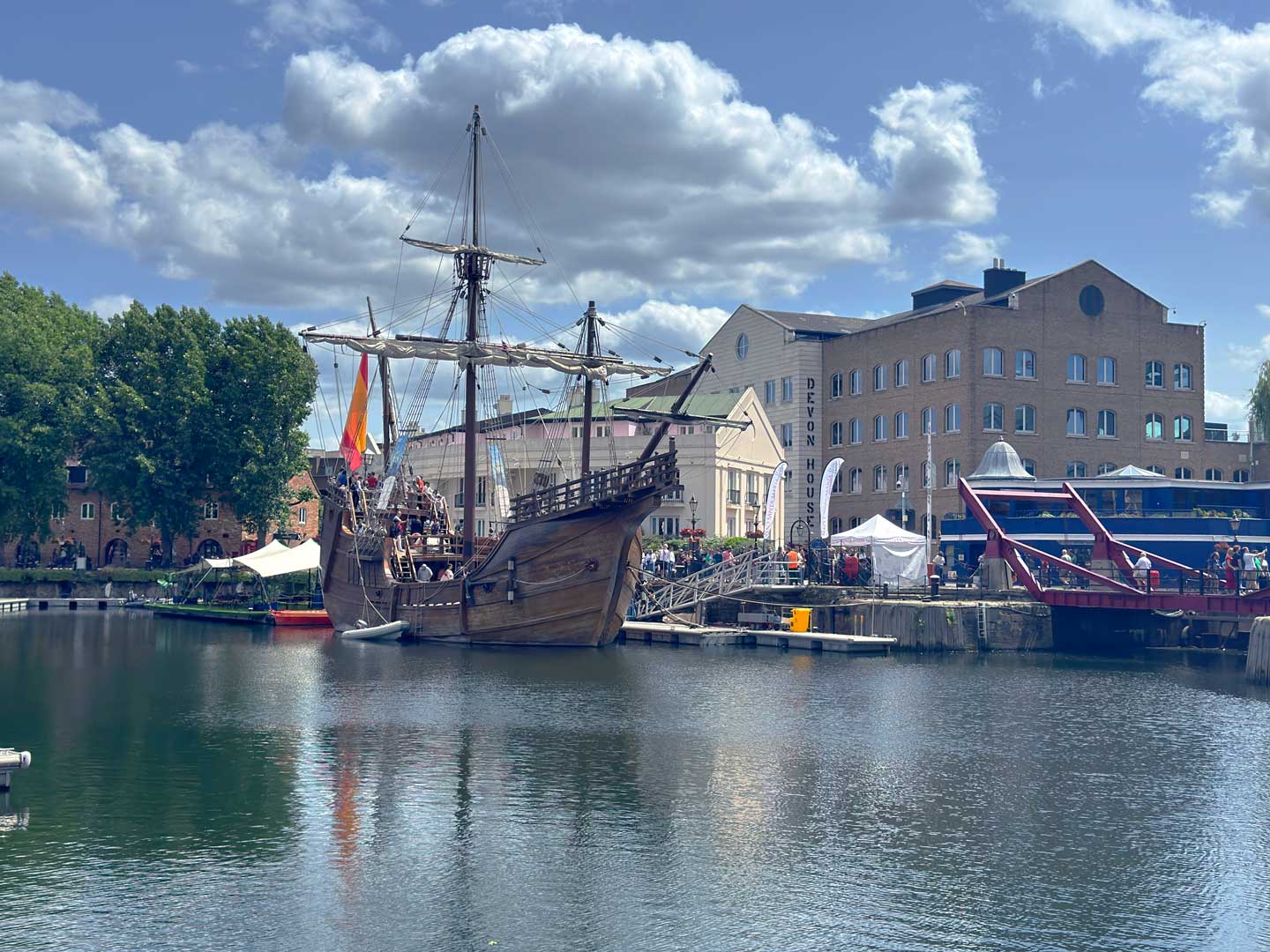It was the second day of June 2025, and I was doing something that has become a quiet ritual in my life since my heart attack—walking. Not just any stroll, but a healing one, through the charming serenity of St Katharine Docks, just beside Tower Bridge in London. What started as part of my cardiac rehabilitation has now turned into something more—a moment each day to reconnect with life, nature, and, unexpectedly, history.
That day, the weather felt like a gentle nod from the universe. The London summer had arrived with soft sunshine, not harsh, just warm enough to ease your shoulders. The sky was dotted with cotton-like clouds, lazily drifting by. A light breeze whispered through the masts of docked yachts, and the water shimmered like silver. I remember thinking to myself, “This is the kind of day where London feels like poetry.”
And then, something caught my eye. A large wooden ship, with tall sails and an unmistakably historic shape, moored right there in the dock. People were gathering around, taking photos, queuing up. I walked closer, curious. That’s when I saw the name etched on the hull—Nao Santa María.
A Surprising Encounter
I hadn’t planned on finding a piece of the 15th century that day. In fact, I didn’t even know it was in London. There were no big banners, no loud announcements. It just stood there quietly, as though time itself had anchored it for a pause.
For a moment, I stood still, taking in its majestic presence. The Nao Santa María was one of the three ships used by Christopher Columbus on his historic voyage across the Atlantic in 1492. The original is long gone, of course, but this full-size replica built by the Nao Victoria Foundation in Spain looked every bit as real, as brave, and as bold as I imagined the original must have been.
There was something deeply moving about seeing this ship up close. This wasn’t just a floating museum; it was a floating memory, a reminder of an era when the sea was the final frontier, and wooden hulls carried dreams into the unknown.
Stepping Back in Time
As I joined the line and stepped aboard, I was struck by the sheer compactness of it all. We often romanticise voyages of exploration, imagining large crews and spacious cabins, but the Nao Santa María tells a different tale. Tight corridors. Low wooden ceilings. Decks creaking gently beneath your feet. It felt like every beam and plank held centuries of stories.
I imagined Columbus and his men aboard this very design, navigating vast oceans without GPS, without weather forecasts—only stars, instinct, and immense courage. How brave they must have been, those sailors of the past, trusting this modest vessel to carry them across thousands of miles of water. It’s not something we think about often, is it? The real, raw human grit that exploration demanded back then.
The guides aboard were friendly and informative, explaining how the replica was constructed using traditional techniques. Every rope, sail, and nail had been placed with historical accuracy in mind. It’s hard not to admire the craftsmanship, but even more, the sheer spirit of the story this ship carries.

A Living History Lesson
The Nao Santa María isn’t a static museum piece hidden behind glass. It’s alive. It moves from port to port across Europe and beyond, inviting people to step into history. In London, it had quietly docked at St Katharine Docks, and many passersby, like me, were discovering it purely by chance. Families, children, tourists, and locals were all climbing aboard, visibly excited, taking photos, asking questions, and learning.
I didn’t know when it arrived, and I still don’t know how long it will stay or where it’s headed next. That uncertainty somehow made the moment feel even more magical. It reminded me that sometimes, the most beautiful encounters are the ones you never plan for.
A Moment to Reflect
Standing on the upper deck, with the Tower Bridge rising in the distance and the city humming quietly beyond, I felt a strange kind of stillness. As someone who’s had a close brush with mortality, these kinds of moments mean more now. To simply be alive, under the open sky, feeling the breeze and touching history—what a gift.
I was also reminded how much London continues to surprise me. Just when you think you’ve seen it all, the city whispers something new. A hidden story. A forgotten artefact. A surprise like the Nao Santa María.
For someone recovering from a heart attack, every step I take now is deliberate. Every breath is appreciated. And that day, my healing path led me to a 15th-century ship in a 21st-century city. Isn’t life wonderfully unpredictable?
A Must-See If You’re in London
If you’re in London, I can’t recommend a visit to St Katharine Docks enough. It’s quieter than the nearby Tower Bridge area but just as rich in beauty. And if by some stroke of luck the Nao Santa María is still docked when you go—don’t miss it. Step aboard. Feel the wood under your feet. Imagine the roaring waves and the uncertain future those brave sailors once faced.
Because history isn’t always locked in books or museums. Sometimes it floats right in front of you, waiting to be discovered during an afternoon walk.
Conclusion
My visit to the Nao Santa María at St Katharine Docks was more than just a lucky encounter—it was a meaningful reminder of how history and personal journeys often meet in the most unexpected places. Whether you’re a history enthusiast, a curious explorer, or simply someone out for a quiet stroll, this floating replica is a treasure worth your time.
In a world moving fast, the Nao Santa María floats calmly, carrying stories of the past, and reminding us to pause, look, and reflect. And on a warm summer day in London, I did exactly that.


